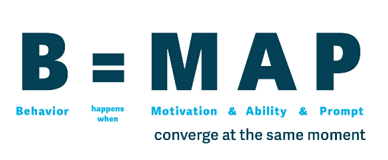
BJ Fogg, PhD, founded the Behavior Design Lab at Stanford University. He’s also the author of Tiny Habits: The Small Changes that Change Everything, and he has identified what it takes to start any new good habit or stop any bad habit you want.
He’s developed the Fogg Behavior Model to map out the elements of how habits get started and get reinforced. Once you understand the process, you’ll be able to tweak your behavior – or someone else’s – to make changes both big and small.
Here’s how it works.

Fogg says that behavior, whether it’s a one-time act or a habit, “happens when the three elements of MAP—Motivation, Ability, and Prompt—come together at the same moment. Motivation is your desire to do the behavior. Ability is your capacity to do the behavior. And Prompt is your cue to do the behavior.”
I developed my walking habit after I left my fulltime job in 2020 (it was helped along by the pandemic.) My motivation was high (building health and strength), but I knew I had to make it easy to walk, even on days I wasn’t feeling motivated. So I dressed in workout clothes every morning. That made it easy to walk first thing in the morning, when the weather is as cool as it will be all day in my Florida town.
As soon as the sun comes up (as early as 6:00 AM in the summer), I head out the door for a brisk 30 minute walk in my neighborhood. The sunrise is my prompt. I reward myself with breakfast and Wordle when I get back home. I haven’t missed more than a handful of mornings in over two years (most were rain delays.)
Once you learn to identify the elements of the model, you can start or stop any behavior. But Fogg says the big mistake most people make is to start with trying to change motivation. Motivation is hard to change. We’ve all experienced how difficult it is to break a bad habit like snacking, scrolling social media, or anything that feels good but isn’t good for you. You have all the information you need (snacks and Twitter bad, healthy eating and lots of sleep good) but the behavior just feels so good that you’re highly motivated to do it. That’s almost impossible to change by willpower and intellect alone.
The easiest place to start changing behavior, Fogg says, is with the prompt, the event that cues the behavior. Create a prompt that reminds you to do something (or stop something): an alarm on your phone, a calendar alert, a sticky note placed where you can’t miss it, or a reminder from your spouse or a friend. You can also remove prompts: remove the snacks from your pantry or delete Twitter from your phone. Removing the prompt can short circuit the behavior cycle.
You can also improve your ability to do a good behavior or make a bad behavior harder. Fogg writes that when his partner asks him to start a habit around the house, he asks him to demonstrate what he wants him to do. Seeing the behavior demonstrated makes it easier to do and to remember.
Amazon and other e-retailers have made purchasing easy b storing credit card information for you. If you had to get up and get a card from your wallet to type in numbers and codes, you’d probably impulse-buy less often.
Fogg writes, “The writers who create clickbait headlines and the designers who craft the apps on our phones know this. There’s a reason many of us can’t resist clicking on an app with a little red number (alerts) on it—that feature has been designed to grab our attention and get us to act. Internet advertisers know that if you can combine a prompt with a motivator (Click here to win a prize!), people will respond in even higher percentages.”
In future posts, I’ll talk about how to implement tiny habits and design prompts that work for you.
Brain works on habits
LikeLike
[…] wrote in a previous post that his behavior model consists of three essential elements: Motivation, Ability, and Prompt. Your […]
LikeLike
[…] wrote in a previous post that his behavior model consists of three essential elements: Motivation, Ability, and Prompt. Your […]
LikeLike